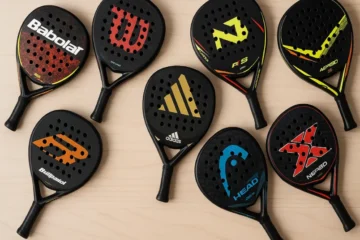Playing padel, like any sport, comes with its fair share of challenges. While many players focus on mastering their swings, improving their footwork, or strategizing with their partners, one element often remains uncontrollable: the wind. It’s something every player has encountered, and while it can be frustrating, the wind doesn’t have to be an enemy to your game. Instead, with the right approach, you can transform it into a challenge that you learn to master.
When the wind picks up, it can feel like you’re suddenly fighting against an invisible force, making it difficult to execute your shots and stay in control. However, with some strategic adjustments to your technique, tactics, and mindset, you can continue playing confidently despite these elements.
This guide will help you not just survive, but thrive, in windy conditions on the padel court. Whether you’re facing a mild breeze or a howling gale, these actionable tips will ensure you can continue performing at your best when the elements challenge you.
Part 1: The Mindset Shift – Embrace the Challenge
Before you dive into the technical adjustments needed for windy conditions, it’s important to shift your mindset. The wind is not something that should be feared; rather, it’s an additional factor to consider and adapt to.
Reframe the Situation
Instead of seeing the wind as a hindrance, view it as a new variable to manage. Just like adjusting to an opponent’s playing style, you’ll need to adjust to the wind. This requires patience and an open mind. The wind is just another part of the game, and the key is learning how to play with it.
Lower Your Expectations
In windy conditions, it’s crucial to adjust your expectations. The gusts of wind will cause unforced errors that wouldn’t normally happen under calm circumstances. By accepting that some mistakes are inevitable, you allow yourself the freedom to focus on consistency instead of perfection. Your goal should be to make fewer errors than your opponent.
Focus on Consistency
When wind is involved, the player who adapts better will win, not necessarily the player who can hit the hardest shots. Consistency becomes the key to success. Windy conditions demand more control, so prioritize hitting reliable shots rather than going for winners. Adapt to the changing conditions, and you’ll find that your game improves.
Part 2: Understanding How Wind Affects the Ball
Wind can dramatically alter the flight of the ball, changing the way you approach your shots. There are three main wind conditions you’ll encounter on the padel court: headwind, tailwind, and crosswind. Each requires a different approach to maximize your effectiveness.
Headwind (Playing Against the Wind)
- Effect: The wind slows down the ball, causing it to drop short.
- Opportunity: While it’s harder to hit deep shots, headwinds make it easier to play at the net. Volleys tend to sit up more, giving you more control in close-range exchanges.
- Adjustment: Focus on hitting with more precision rather than power. Use shorter strokes and focus on placing the ball deep into the court or at the feet of your opponent to minimize their response time.
Tailwind (Playing With the Wind)
- Effect: A tailwind makes the ball travel faster and deeper, potentially surprising you with its increased speed.
- Opportunity: The wind can be a great ally for serves and powerful shots. The added distance can help your shots travel with more velocity.
- Adjustment: Use the tailwind to your advantage by hitting strong serves and powerful groundstrokes. However, be cautious with lobs and delicate shots, as the wind can carry them out of bounds if not executed properly.
Crosswind (Wind from the Side)
- Effect: Crosswinds cause the ball to curve or drift sideways in the air, which can make it difficult to judge its final trajectory.
- Challenge: Crosswinds can alter the bounce and trajectory of the ball significantly, making it tricky to anticipate where the ball will land.
- Adjustment: You’ll need to be more aware of the ball’s movement and adjust your position accordingly. Keep a low stance and be prepared to react quickly to the unpredictable bounces caused by the wind.
Part 3: Tactical & Technical Adjustments for Windy Play
Once you understand how the wind affects the ball, it’s time to focus on tactical and technical adjustments that will help you stay competitive.
A. Mastering Your Shot Selection
The wind will impact your shot selection, so it’s important to know when and how to use specific shots.
The Lob is Your Best (and Worst) Friend
- With the Wind: Lobs are dangerous when played with a tailwind. The ball will travel too far, making it difficult to control. If you do use the lob, aim higher to give it more margin for error.
- Against the Wind: The wind can actually help you with lobs when you’re playing against it. A flatter trajectory and more power will help the wind bring the ball down quickly, making it harder for your opponents to intercept.
Embrace the Low Ball
In windy conditions, low balls are your friend. Low shots like bandejas, viboras, and hard volleys are less affected by the wind and can be more consistent.
- Adjustment: Keep the ball low over the net to reduce the wind’s impact on its flight. Low balls are difficult for opponents to handle, especially if they’re forced to volley or retrieve them from below the net.
Forget the “Winner”
When playing in windy conditions, it’s best to avoid going for delicate drop shots or extreme angles. The wind will make these shots unreliable, and trying for a “winner” will likely lead to more unforced errors.
- Adjustment: Focus on building the point by playing steady, reliable shots. Look for opportunities to force your opponent into a mistake rather than trying to end the point too early.
B. Adjusting Your Stroke Technique
To handle the challenges of the wind effectively, you may need to modify your stroke technique.
Shorter Backswing
Using a shorter backswing can improve your control in windy conditions. A compact swing allows you to make adjustments at the last moment, helping you counteract the effects of the wind.
- Adjustment: Shorten your backswing to help with consistency. A smaller range of motion gives you more control over the ball, allowing for better timing and placement.
Firmer Grip & Wrist
When facing strong winds, your racket may be more prone to twisting at impact. To prevent this, maintain a firmer grip and keep your wrist stable.
- Adjustment: By stabilizing your racket face through impact, you can prevent the wind from affecting the flight of the ball and ensure better control.
Watch the Ball Closer Than Ever
In windy conditions, the ball’s flight path will be altered, making it crucial to stay locked in on the ball at all times.
- Adjustment: Focus intensely on the ball from the moment it leaves your opponent’s racket to the point of contact. This will help you adjust your positioning to the unpredictable wind effects.
C. Strategic Positioning & Movement
Positioning and movement are vital in windy conditions. Here’s how you can adjust:
At the Net
- Adjustment: Be more conservative when playing at the net. You don’t need to dominate the net; instead, focus on protecting it. Stand slightly further back than usual to account for lobs carried by the wind.
At the Back
- Adjustment: When playing from the back of the court, be prepared to move laterally quickly. Wind can cause the ball to drift unpredictably, so you need to react faster to handle the altered flight paths.
The Golden Rule of Positioning
- Adjustment: Always err on the side of being too deep rather than too close to the net. This will allow you more time to adjust to the ball, especially when it’s affected by crosswinds.
Part 4: The Serve and Return of Serve in the Wind
Windy conditions can dramatically affect both serving and returning, so understanding how to adapt your approach is key.
Serving
With the Wind
- Adjustment: Use a softer, more controlled serve. Instead of focusing on power, concentrate on placement to ensure the ball stays in the service box despite the wind.
Against the Wind
- Adjustment: Add more pace to your serve to ensure the ball reaches the service box. A stronger serve can cut through the wind and maintain its intended path.
Returning Serve
The primary goal when returning serve in windy conditions is to get the ball back into play safely.
- Adjustment: Focus on deep, low returns, particularly cross-court bandejas or low, defensive volleys. These shots minimize the wind’s effect and make it difficult for your opponent to attack.
Part 5: The Power of Communication & Partnership
Effective communication with your partner is more important than ever in windy conditions.
Talk Constantly
Wind can create confusion, especially when the ball is drifting unexpectedly. Constant verbal communication is essential.
- Adjustment: Use calls like “I got it!” and “Yours!” to avoid miscommunication. Acknowledge the wind’s impact by saying things like, “Watch the wind!”
Decide on a Lob Strategy
The wind will affect how lobs travel across the court. To handle this, you and your partner should decide on who will cover the side with the wind.
- Adjustment: The player on the downwind side should cover more of the court for lobs, ensuring that the wind doesn’t leave either of you caught out of position.
Stay Positive
In windy conditions, mistakes are inevitable. Maintaining a positive attitude is crucial to staying focused.
- Adjustment: Encourage each other after mistakes and celebrate the small victories. A positive team spirit will help you remain resilient against the challenges of the wind.
Conclusion
Playing in windy conditions doesn’t have to be a daunting challenge. By adapting your shots, simplifying your strategy, and maintaining a calm and patient mindset, you can continue to excel on the padel court, no matter what the weather throws at you. Over time, mastering the art of playing in the wind will make you a more complete and formidable player. So, the next time the wind picks up, embrace it as an opportunity to improve your game and rise to the challenge.
FAQs
1. How does wind affect my padel game?
Wind can drastically alter the flight path of the ball, making it harder to control. It may slow the ball down in headwind conditions, speed it up in tailwind conditions, and cause it to drift in crosswind conditions. Understanding how the wind impacts the ball will help you adjust your strategy.
2. What shots work best in windy conditions?
Shots that stay low over the net, such as bandejas, viboras, and low volleys, are ideal in windy conditions. Avoid delicate drop shots and extreme angles, as the wind will make them inconsistent.
3. How can I improve my serve in windy conditions?
With the wind at your back, focus on placing your serve more accurately rather than hitting with power. When facing a headwind, you’ll need to put more pace on your serve to ensure it reaches the service box.
4. How should I position myself on the court in the wind?
At the net, stand slightly further back to account for lobs carried by the wind. At the back of the court, be prepared to move laterally quickly as the wind can cause the ball to drift. Always err on the side of being too deep rather than too close to the net.
5. What mindset should I have when playing in the wind?
Embrace the challenge of windy conditions by adjusting your expectations. Focus on consistency and accept that mistakes will happen. The player who adapts best to the wind will usually come out on top, not necessarily the one with the most powerful shots.




